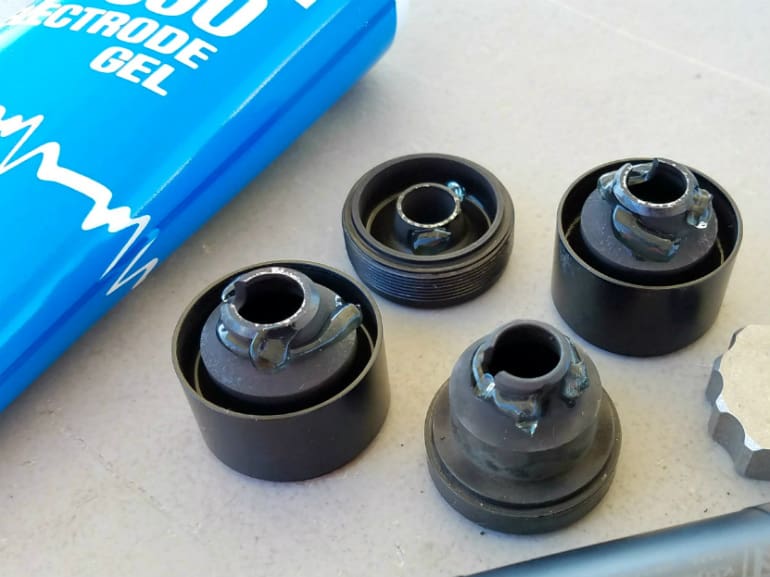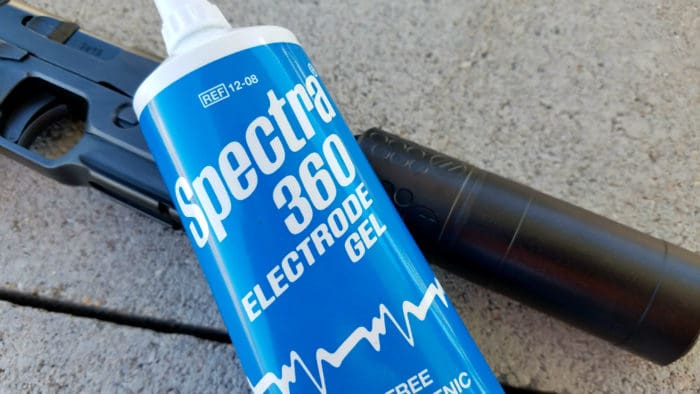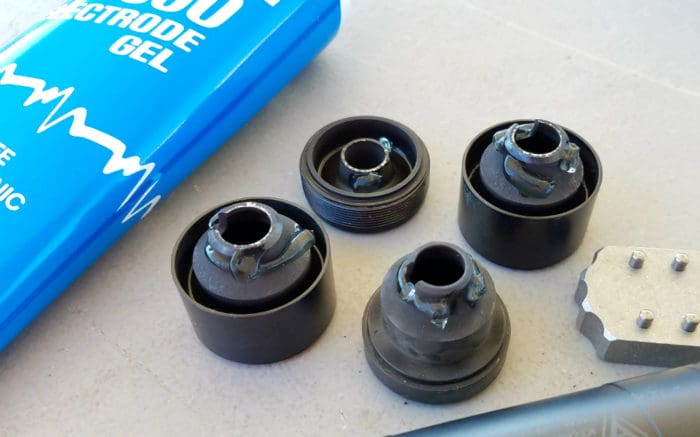Suppressor technology has come a long way, and it’s the rare exception, indeed, that isn’t hearing safe when shot dry. Even so, you may still want to shoot your suppressor wet. But what does that mean, anyway, and what the heck is ablative?
A firearm silencer/suppressor quiets a gunshot primarily by slowing down, expanding (in a controlled fashion), and cooling high-pressure combustion gases before they leave the suppressor. This massively reduces the pressure — from thousands of pounds per square inch to dozens — thereby reducing the loud “bang” of a gunshot. Think of popping a champagne cork versus easing it open, or popping a balloon versus letting the air out the mouth.
All of this energy must be sucked out of the muzzle gases by the “can” before the gas leaves the suppressor. And that gas is moving damn fast. We can help the suppressor do its job by using an ablative medium — material that pulls heat out of hot gas better than metal does.
In this context, we’re more or less borrowing the word “ablative” from the fire protection and aerospace industries, where it’s used to describe a sacrificial medium designed to absorb and disperse heat by evaporating or burning off. Converting a liquid, gel, or solid into a gas takes energy. And taking energy from the ammo combustion gas is our goal.
Shooting a suppressor “dry” means shooting it as-is. Nearly every modern suppressor on the market is optimized for shooting dry (notable exception), and, unless it’s specifically stated otherwise, any decibel rating information you see is with the suppressor dry.
Shooting a suppressor “wet” means shooting it with ablative media added to the inside. This will typically reduce the sound volume by an additional three to 10 dB versus shooting the same suppressor dry. Don’t worry, you don’t [yet] have to register ablative under the NFA.
As a reminder, reducing sound by three decibels technically cuts the sound intensity level by half. Reducing it by 10 decibels, to most people, cuts the perceived noise level in half. So, while going from 131 dB to 121 dB may not look like a lot on raw numbers, to your ears (and brain) it’s a pretty huge change. Stated in the opposite manner, 131 dB sounds twice as loud as 121 dB.
So, let’s add some ablative . . .
The most common ablative medium for use in suppressors is good ol’ water. It’s an extremely effective choice, but it has some downsides. Namely, it’s thin so it leaks out and typically blows back out of the action to varying degrees while shooting. It also evaporates quickly — a reason it’s so effective — so, in most cases, it can’t be added to a suppressor far in advance of shooting as it will be gone by the time you shoot.
The most popular alternative is wire pulling gel, aka cable pulling lubricant. This stuff is cheap and can be found at most hardware stores, online, and, certainly, at electrical supply stores. Its normal use is to lubricate wire or a cable before pulling it through a tight-fitting insulation or protective sleeve.
The consistency of these gels/lubricants varies from thin like liquid dish soap to thick like waxy petroleum jelly. Downsides can be mess and smoke. The thin stuff is cleaner, the thick stuff stays in place better and doesn’t evaporate.
What I use is seen above: ultrasound gel. It’s easiest to find online (I buy this stuff on Amazon and three tubes lasts a long time) and though it’s a bit more expensive than most wire pulling gel it’s still just pennies per use. Plus, ultrasound gel does have some advantages.
Ultrasound gel is clean. Really clean. And safe. Plus chicks dig it. Pregnant ones, in particular. Seriously though, it wipes cleanly off skin and it burns cleanly out of your suppressor; no residue, no smoke. It’s thick enough to stay in place pretty well, but it’s watery enough to boil off rapidly and suck lots of heat out of your muzzle gases lickety-split. It’s fairly ideal.
If your suppressor disassembles, great. This allows access to each baffle for manual application of ablative. About 5cc of ablative (approximately the amount a plastic bottle cap holds), regardless of flavor, is enough to make a big difference.
If your suppressor doesn’t disassemble, no worries. As those ammo combustion gases are hottest and under highest pressure closest to the firearm’s muzzle, ablative tends to make the biggest sound reduction difference when applied in the first part of the suppressor anyway.
Water can simply be poured in there, then some shaking and turning and wobbling of the suppressor will distribute it around and down into the baffle stack. Or, with ultrasound gel from a tube, you can squeeze out a four-to-six-inch worm of material, dangle it from the tube, and lower it into the bore of the suppressor before flipping the suppressor on its side to drop that worm down into the baffles.
Depending on caliber, barrel length, suppressor design, ablative material, amount of ablative, and other variables, you can expect five to 30 rounds of extra quiet shots before the ablative has completely evaporated and burned away and volume levels return to normal, “dry” levels.
SAFETY NOTE: there is absolutely such a thing as too much ablative. Unlike air, these mediums do not compress. Empty air space is still a must inside most suppressors.
Too much ablative can lead to increased internal pressures and even a popped suppressor. The risk of this is significantly higher with centerfire rifle calibers than with pistol calibers. Five cubic centimeters of ablative is considered conservative and safe, but always follow manufacturer recommendations and guidance.
Additionally, it’s best not to block or impede the bore — the bullet’s path. We want it to fly straight for obvious reasons, and certainly don’t want to deflect it so badly that it strikes a suppressor baffle. With ablative, as with everything, enjoy in moderation.
Seen above are the baffles of my CGS Group Kraken SK after 90 rounds of shooting wet with ultrasound gel applied to each baffle every 30 rounds. I think they’re actually cleaner than they were prior to shooting this suppressor wet for the first time.
As seen in the video above, the difference between wet and dry in this case is quite meaningful. Obvious in person, obvious on the video. Unsurprisingly, the hotter the ammo, the bigger the difference between wet and dry.
Just as sound reduction wet vs. dry varies with ammo choice in this particular suppressor, so will the difference between shooting dry and shooting wet vary in other cases. Suppressor design, caliber, barrel length, specific ammunition, environmental factors, ablative medium type and quantity, and more will effect the end result.
So go out and experiment! Safely. If you’re unsure, contact your suppressor manufacturer for guidance or consult the experts at Silencer Shop.









200+ days my can has been in jail. I stopped counting. Stupid fucking ATF. At this point I’m just worried about my dog.
Was it an E-Form4 application?
The alphabet boys stated they would direct employee support to keep the E-Form applications to under 90 days. Paper applications are still taking around a year.
I’ll be at 90 days (post Form4 certification) in a couple days.
Nice H9. I was waiting for the H45, but Hudson closed down before it became a reality. 🙁
It was done at the kiosk. I’ve called twice and I get the same response both times followed by a silence that indicates they are thinking “what do you want us to do about it?”.
I bought it on dec. 1st, they received it feb 4th. ATF and the VA are two peas in a pod.
Thanks Jeremy very good explanation. Never thought of ultrasound gel. Very easy clean up and chicks dig it hahaha
Wire pull gel works.
Inland has a oblative product called “db Foam”. Water soluble and rust inhibitor, suppressor can be stored with the stuff inside.
It works great too.
guys here use wire pull gel when they want to fire wet, they swear by it.
“Inland has a oblative product called “db Foam”.”
dB Foam is like 20 bucks a can.
I need to experiment with shaving cream…
Yes.
It’s best to get a group together and buy a few cases from a retailer or FFL who will work a bulk purchase deal.
I have a few cans that are around 5 years old. IIRC they were around $10 each.
Wow, I bet you could fill the can with dish soap and blow bubbles.
Thatd be cool.
Try Possum snot ™… 🙂
I smell a potential business, “Possum Snot ™” silencer goo.
The can has a Possum on the label, with his tail wrapped all the way ’round the can… 🙂
Put me down for a case. 😄
You don’t need to buy possum snot.
Just scrape it out from under an F150.
So astroglide would work? I’ve got tons of that laying around.
You want it to be water-soluble.
If Astro is one of those silicone-based ‘lubes’, it won’t flash to steam when the hot muzzle gas hits it…
LOL
KY Jelly works also and it comes in flavors! The only other use I know for KY.
THANK FOR NICE INFORMATION, VISIT OUR WEBSITE : https://telkomuniversity.ac.id/
Thank for the information, please visit
VisitUs
Can anyone convert 5 cubic centimeters too cc’s from a syringe for my center fire cans? I’ve been using 10 drops of water but want to use the gel this guy uses. I use it in my pistol cans and just put a dab in my blast chamber. Works for about 10 shots of 45 or 9mm. 10mm I only use a tiny bit rubbed inside the cans walls. My cans are quite large and top tier. Also is the blast chamber better to add too or the muzzle end. thanks